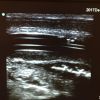Stroke patient…order CT…admit patient…no role for POCUS :( Ho hum…
What is the role of the acute-care clinician in strokes? In large part, it’s really unexciting. We all know that. All need a CT which is usually normal. Most get admitted. Whether they are devastating or trivial, there’s not much that we can do about it (if this makes you think about lytics, go to EM Cases for an update on that literature).
Is there a role for POCUS? Actually, there is! You knew I was going to say that 🙂 One use is looking at the middle cerebral artery. That’s a bit tricky so we’ll save that for another day and a discussion of EDE 4 topics! Here is a case from Dr Lloyd Gordon from Humber that illustrates something you can look for that is pretty straightforward. Here’s Lloyd:
“We were just discussing this topic at rounds a few days ago. On my very next shift, my 2nd patient was a man in his late 50s with mild DM who woke up with a left sided CVA. It started with left arm and leg weakness and progressed to a dense hemiplegia and facial nerve paresis. After doing a POCUS of his heart which was negative, I scanned his carotids in the longitudinal and transverse planes.
Longitudinal
Transverse
Sure enough the right carotid had what looked like an intimal flap, presumably a carotid dissection. The point was made at rounds a few days prior that CVAs due to carotid dissections tends to occur in younger patients.”
Ed. note: This scan is really quick to do. Note that Lloyd also scanned the heart. While not all stroke patients need their heart scanned, the A-fibbers and those with bad hearts are worth scanning. You will find the occasional clot suggesting an embolic source. And you will find the clot WAY sooner than an elective echo, even when admitted.






